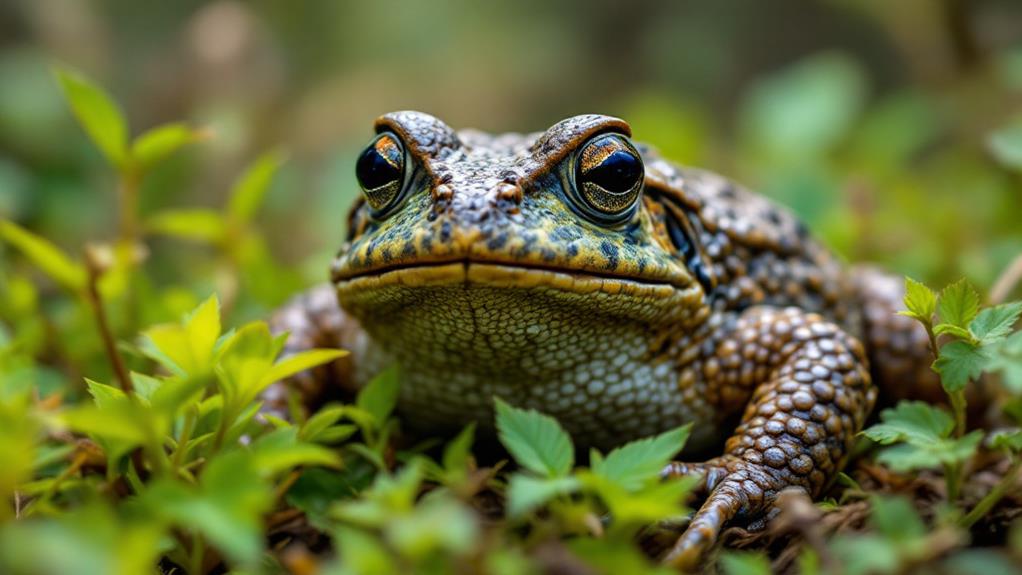Why Was the Cane Toad a Failure as a Biological Control in Australia?

The cane toad was a failure as a biological control in Australia because it couldn't effectively target the pests it was meant to control, specifically the greyback beetles. These nocturnal beetles lived high on sugar cane stalks, out of the toads' reach. Furthermore, the toads' prolific breeding led to massive population growth, causing ecological harm by poisoning native predators and competing for resources. They didn't reduce pest populations or improve agricultural yields. Instead, they disrupted local ecosystems. This invasive approach backfired, impacting both agriculture and ecology. Uncover more about how assumptions and misjudgments led to this ecological conundrum.
Historical Background
Cane toads were brought to Australia in 1935 to combat beetles destroying sugar cane crops. This introduction aimed to use the toads as a form of biological control, expecting them to curb the pest beetles threatening the sugar cane industry. You might think this plan was backed by solid reasoning, given the historical evidence of successful introductions elsewhere. However, the reality in Australia unfolded quite differently, leading to significant ecological disruption instead of relief.
Initially, around 10,000 cane toads were released, but their population exploded to approximately 120 million. This massive population growth didn't translate into the intended control over pest beetles. Instead, the toads caused harm to native species, disrupting local ecosystems and creating widespread ecological damage. The introduction, based on earlier successes, overlooked critical factors such as the unique ecological conditions in Australia.
Despite the hopes pinned on the cane toads, analyses showed no increase in sugar cane yields following their release. The absence of statistical improvements in crop production highlighted the failure of this biological control method. By introducing cane toads, Australia witnessed a cautionary tale about the complexities and unforeseen consequences of manipulating ecosystems with non-native species.
Target Species Mismatch
While the introduction of cane toads in Australia was initially seen as a promising solution, the reality quickly revealed a critical flaw: a mismatch between the toads and their targeted pest, the greyback beetles. Cane toads were brought in as a biological control to curb these beetles in sugar cane crops, but their nocturnal feeding habits clashed with the diurnal activity patterns of the greyback beetles. This mismatch meant that the cane toads were largely ineffective in reducing beetle populations when they were most active.
Furthermore, greyback beetles inhabit the upper regions of sugar cane stalks, typically 6-8 meters high, which are far from the reach of ground-dwelling cane toads. This physical barrier further hindered the toads' ability to serve as effective pest control agents. In addition, seasonal mismatches between the cane toads' breeding and feeding periods and the life cycle of the target species compounded the problem. The toads' moisture requirements also led them to move away from the agricultural areas where pest control was most needed. Consequently, cane toads failed to make a significant impact on the greyback beetle population, undermining their role as an introduced biological control method.
Ecological Disruptions

One might wonder about the unintended consequences of introducing a species like the cane toad to a new environment. In Australia, cane toads have caused significant ecological disruptions. Their toxic nature led to drastic declines in native predator populations, such as varanid lizards and northern quolls. These population crashes disrupted local food webs, allowing pest populations to surge unchecked. The imbalance created by the decline of these native predators illustrates the major impact invasive species can have.
Cane toads don't just affect predators; they also outcompete native species for food and breeding sites. This competition has resulted in declines of native amphibians and small mammals, further altering the ecological balance. The toads' broad diet includes beneficial insects, like ants, which are essential for controlling pest populations. By consuming these insects, cane toads inadvertently contributed to increased pest populations.
Moreover, their rapid breeding—females can lay up to 30,000 eggs at a time—results in explosive population growth. This unchecked increase exacerbates ecological disruptions, intensifying competition with native species. Ultimately, the introduction of cane toads has led to widespread ecological consequences that ripple through the environment, showcasing the challenges posed by invasive species.
Agricultural Consequences
Beyond the ecological disruptions, the introduction of cane toads in Australia also had unexpected consequences for agriculture. You'd think that adding a biological control agent would help reduce pest populations affecting sugar cane yields. However, cane toads failed in this role. They were brought in to control greyback beetles, notorious for damaging sugar cane. But here's the catch: cane toads couldn't reach these beetles. The beetles were high up on the sugar cane stalks and fed at night, making the toads' predation efforts ineffective.
Instead of reducing pest numbers, the toads' toxic nature affected apex predators that naturally controlled other pests. As these predators declined, pest populations actually increased, causing more agricultural damage than before. Farmers hoped for an increase in sugar cane yields, but statistical analyses showed no significant improvement after the toads' introduction. The initial expectations for pest control were unmet, leading to more crop-consuming species during the toads' reproductive phases.
Ultimately, the adverse ecological consequences of cane toads extended to agriculture, highlighting their role as a failed biological control measure. Their introduction did more harm than good, proving ineffective in addressing the intended pest control challenges.
Breeding and Dispersal

Cane toads are exceptional breeders, with females laying between 8,000 and 30,000 eggs at a time, leading to explosive population growth. This prolific breeding contributes to their status as an invasive species in Australia. The rapid development of cane toad tadpoles, lasting just 4 to 8 weeks, allows these amphibians to quickly mature and disperse into new habitats. Their incredible reproductive rates enable them to overwhelm native ecosystems, outcompeting local species for resources.
As a cane toad, you can expand your territory at an impressive rate of 40 to 60 kilometers per year. This swift colonization complicates control efforts, as you move into new areas faster than humans can respond. The sheer number of cane toads, reaching an estimated peak of 120 million individuals, makes it almost impossible for control measures to keep up with the burgeoning population.
Your ability to thrive in diverse environments only adds to the challenge. High reproduction rates and rapid dispersal guarantee that you continue to spread across Australia, altering ecosystems and outpacing efforts to manage your population. As a result, the introduction of cane toads has become a cautionary tale of biological control gone awry.
Environmental Adaptations
Adapting to varied environments has been vital to the cane toad's success in Australia. Cane toads are remarkably adept at surviving in multiple habitats, from moist areas imperative for their survival to urban zones and agricultural landscapes. This adaptability makes them highly invasive, complicating control efforts as they spread quickly, covering 40-60 km annually. Unlike many species, cane toads lack natural predators in Australia, allowing their population growth to proceed unchecked. Their resistance to local environmental changes further improves their ability to thrive, making them a formidable invasive species.
Their nocturnal foraging is an interesting aspect of their environmental adaptations. By hunting at night, cane toads avoid the activity periods of target pests like greyback beetles, creating a mismatch in predator-prey interactions. This misalignment means they fail to control the pests they were introduced to manage. Yet, they continue to breed prolifically, with each cycle producing between 8,000 to 30,000 eggs, greatly increasing their populations. Without natural predators to curb their numbers, they persist and expand, causing ecological disruptions in the habitats they invade. Such environmental adaptations highlight why cane toads have been so challenging to manage in Australia.
Management Strategies

Australia has implemented several targeted management strategies to control the invasive cane toad population. You'll find localized humane control methods, like egg collection and adult disposal, being used to reduce cane toad populations in vulnerable areas. These efforts aim to protect native wildlife and limit ecological impacts. Fine-mesh fencing is another control method, effectively safeguarding sensitive ecosystems, such as ponds, from cane toad invasions, highlighting a focused approach to conservation.
Monitoring is vital in understanding cane toad populations and their ecological impacts. By keeping track of their spread and effects, you can adapt management strategies accordingly. One inventive approach being investigated is conditioned taste aversion (CTA), which aims to train native predators, like crocodiles, to avoid toxic cane toads. This method shows promise in reducing predator mortality.
Community-based control is fundamental in the fight against cane toads. The Australian Government has committed over $2 million to support these activities and sustainable research. This funding encourages communities to engage in monitoring and control efforts, fostering a collective approach to conservation. By leveraging these management strategies, you contribute to minimizing the ecological damage caused by cane toads.
Lessons Learned
While numerous management strategies have been implemented to control cane toads, the experience in Australia offers significant lessons for future efforts. The introduction of cane toads as biological control agents was based on flawed assumptions, leading to ecological disruption instead of resolving pest issues. Their presence resulted in severe unintended impacts, such as declines in native predator populations. These predators, unadapted to the toads' toxic defenses, suffered drastically from toxic ingestion.
One of the key lessons learned is the necessity of thorough risk assessments before introducing any invasive species. You can't afford to overlook the behavior and potential ecological consequences of the target species. In the case of cane toads, there was no significant increase in agricultural productivity, particularly in sugar cane yields, which underscores their ineffectiveness in pest management.
The failure of cane toads in Australia highlights the importance of considering ecosystem compatibility. Future strategies should prioritize understanding the complex interactions within ecosystems to prevent similar mistakes. This experience emphasizes that detailed planning and scientific understanding are vital when contemplating biological control measures, ensuring they don't cause more harm than good. Moving forward, informed decisions can foster better pest management without compromising ecological balance.




